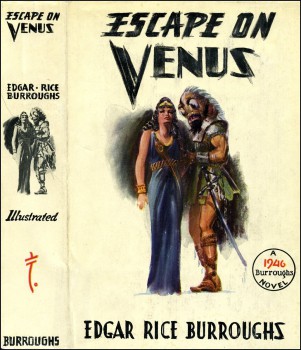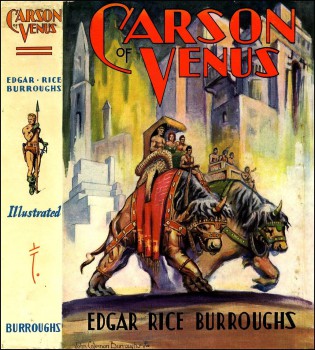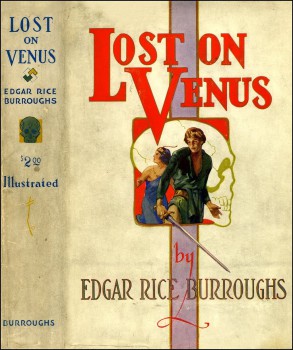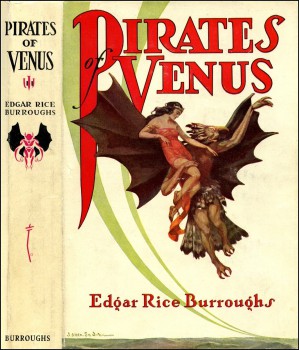Edgar Rice Burroughs’s Venus, Part 4: Escape on Venus
 I love Edgar Rice Burroughs. His novels have had an enormous influence on me as a writer and as a pulp fan. But, I must admit, sometimes he wrote … this kind of thing….
I love Edgar Rice Burroughs. His novels have had an enormous influence on me as a writer and as a pulp fan. But, I must admit, sometimes he wrote … this kind of thing….
Oh, let’s just leap into this and get it over with.
Our Saga: The adventures of one Mr. Carson Napier, former stuntman and amateur rocketeer, who tries to get to Mars and ends up on Venus, a.k.a. Amtor, instead. There he discovers a lush jungle planet of bizarre creatures and humanoids who have uncovered the secret of longevity. The planet is caught in a battle between the country of Vepaja and the tyrannical Thorists. Carson finds time during his adventuring to fall for Duare, forbidden daughter of a Vepajan king. Carson’s story covers three novels, a volume of connected novellas, and an orphaned novella.
Previous Installments: Pirates of Venus (1932), Lost on Venus (1933), Carson of Venus (1938).
Today’s Installment: Escape on Venus (1942)
The Backstory
At the start of the 1940s, Edgar Rice Burroughs decided to try an experiment with three of his properties, all of which had sailed into creative doldrums: Mars/Barsoom, Pellucidar, and Venus/Amtor. The previous Barsoom novel, Synthetic Men of Mars (1939), is one of the few stains on that otherwise superlative series. The Pellucidar novels went into a decline with 1937’s Back to the Stone Age and hit bottom with Land of Terror, which Burroughs failed to sell to any magazine when he wrote it in 1938 and waited to publish it on his own in 1944. Carson of Venus has some positives, but the Venus novels are already much lower on the quality scale of Burroughs’s work. Something wasn’t going right, and the failure to sell Land of Terror must have worried ERB.
It wasn’t just that Burroughs’s writing was in a slump — although it was — that was causing problems, but also the economic realities that were starting to kill the pulp magazines. Comic books exploded at the end of the 1930s and competed for the same young male audience that read the pulps. The magazine companies started cutting back their titles and publishing schedules; this led to reducing the number of serials they ran. Serials work well for a weekly magazine; for a monthly, not so much. Readers wanted their stories complete in each issue, and the publishers couldn’t afford to argue.
 Five years have passed since Edgar Rice Burroughs wrote Lost on Venus, and the world has undergone a startling and disturbing metamorphosis. Something sinister and confusing is taking place in Europe, and across the Atlantic waters the people of the United States are growing concerned at the saber-rattling of Nazi Germany. The poverty-crippled period in which ERB wrote the previous Venus books has given way to a time of escalating fear of a second great war.
Five years have passed since Edgar Rice Burroughs wrote Lost on Venus, and the world has undergone a startling and disturbing metamorphosis. Something sinister and confusing is taking place in Europe, and across the Atlantic waters the people of the United States are growing concerned at the saber-rattling of Nazi Germany. The poverty-crippled period in which ERB wrote the previous Venus books has given way to a time of escalating fear of a second great war. The parade on the second planet continues in Lost on Venus. This is one of the most controversial works that Edgar Rice Burroughs ever published, although it surprises me that enough readers managed to get through the lackluster first book, Pirates of Venus, to want to pick up the sequel and be able to argue about it. But here it is, so get out your anti-tharban gear and be ready to test your genetic purity!
The parade on the second planet continues in Lost on Venus. This is one of the most controversial works that Edgar Rice Burroughs ever published, although it surprises me that enough readers managed to get through the lackluster first book, Pirates of Venus, to want to pick up the sequel and be able to argue about it. But here it is, so get out your anti-tharban gear and be ready to test your genetic purity! Next year brings the hundredth anniversary of Edgar Rice Burroughs’s first two published novels:
Next year brings the hundredth anniversary of Edgar Rice Burroughs’s first two published novels:  Right now, as I type this and most likely as you read it, a movie titled John Carter of Mars, based on the Edgar Rice Burroughs novel A Princess of Mars, is in production. Not in development. Not in pre-production. Not in meetings. It is in front of cameras. Andrew Stanton, director of the brilliant CGI Pixar films Finding Nemo and WALL·E, is shooting John Carter of Mars from a script by Stanton, Michael Chabon, and Mark Andrews, in London this very minute, in this dimension, and it will reach theaters in 2012, in time for the novel’s one hundreth birthday.
Right now, as I type this and most likely as you read it, a movie titled John Carter of Mars, based on the Edgar Rice Burroughs novel A Princess of Mars, is in production. Not in development. Not in pre-production. Not in meetings. It is in front of cameras. Andrew Stanton, director of the brilliant CGI Pixar films Finding Nemo and WALL·E, is shooting John Carter of Mars from a script by Stanton, Michael Chabon, and Mark Andrews, in London this very minute, in this dimension, and it will reach theaters in 2012, in time for the novel’s one hundreth birthday. The People That Time Forgot (1977)
The People That Time Forgot (1977)

 “You have read the opening paragraph, and if you are an imaginative idiot like myself, you will want to read the rest of it; so I shall give it to you here…”
“You have read the opening paragraph, and if you are an imaginative idiot like myself, you will want to read the rest of it; so I shall give it to you here…”